US airports of all sizes and purposes have had to be smart about preparing for winter. Tom Batchelor looks at some of the most successful
Each winter, airports across the United States spring into action with complex and well-tested plans to cope with adverse weather. Preparing for snow and ice is a demanding, expensive process that requires months of training, investment in equipment and collaboration among all airport stakeholders. To support this endeavour, at the end of 2022, the Federal Aviation Administration (FAA) provided winter snow preparation funding for 85 airports – large and small – across 28 states. More than $76.2m was offered to pay for snow ploughs, de-icing equipment and new or upgraded buildings to store winter equipment.
The funding forms part of the FAA’s Airport Improvement Program (AIP), and covers a variety of projects including construction of new and improved airport facilities, repairs to runways and taxiways, maintenance of airfield elements such as lighting or signage, and the purchase of equipment needed to operate and maintain airports. “We can’t let winter weather stop aircraft from safely landing and taking off. This funding will help keep airports operating this winter and get passengers and cargo to their work, families and vacations safely,” said Shannetta Griffin, the FAA’s associate administrator for airports. Around $46.2m will be used to purchase snow removal equipment, $3.1m of it earmarked for Ted Stevens International Airport (ANC) in Anchorage, Alaska.
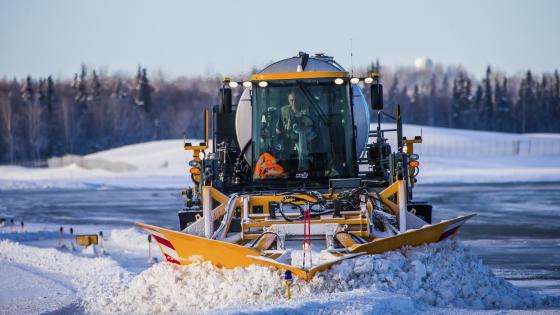
Specialised runway plough trucks are among the heavy-duty equipment required during the harsh Alaskan winter
Preparation is key
It might snow frequently in this part of the US, but remarkably, ANC has never closed as a result of winter weather. Anchorage International Airport was the winner in the large commercial category of the Balchen/Post Award at the 54th Annual International Aviation Snow Symposium in May 2022 – a ceremony honouring the work of snow crews at airports across the ‘Snow Belt’for their efforts in keeping airports safe and operational during the chilly 2021-22winter season.
“At ANC, snow and ice control is routine – it’s what we do,” said Zaramie Lindseth, ANC’s airfield maintenance manager. “Unlike many US airports, a 6-8in snow event is not viewed as an unfamiliar occurrence or an emergency situation; it’s business as usual,” he told Airports International. “Through the years we’ve developed a top-notch snow-fighting fleet, effective techniques, and, most importantly, an incredible team ofsnow and ice professionals dedicatedto the cause of maintaining safeairfield surfaces.”
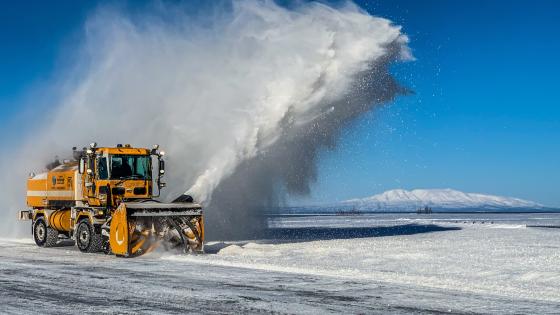
Year-round preparation means that ANC has never been forced to close as a result of winter weather
Lindseth explained a number of factors set ANC apart from other airports. One is the degree of its in-depth preparedness, another is the effectiveness of its snow and ice control programme, and the timeliness and accuracy of communications during any snow and ice control effort. “We have a lot of opportunity to exercise our procedures, averaging 30 to 40 snow and ice control events each winter season,” he said.
“It starts with effective planning and preparedness. Winter operations planning and preparedness is a year-round effort which involves all members of the ANC-Airfield snow-fighting crew. From selecting and stockpiling proper surface treatments, to maintaining state-of-the-art equipment, to negotiating supply-chain challenges, to executing effective employee training programmes, it’s a 24/7/365, never-ending, team effort. The ANC snow team is fully staffed day and night and completely prepared to confidently respond at a moment’s notice.
“Another huge factor involves fostering solid partnerships and communications among the various airport communities to ensure all parties are moving toward the same goal: safe, uninterrupted winter airport operations.”
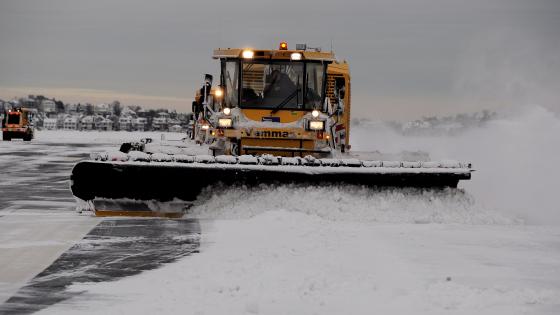
The Vammas multi-purpose unit is Boston Logan Airport’s first line of defence against heavy snow
Federal funding
ANC, like many US airports, is eligible for and takes advantage of FAA AIP funding in the form of grants. ANC uses the grants to cover the cost of some primary snow removal equipment such as specialised runway plough trucks, massive snow blowers, and tow-behind hydraulic-driven rotary broom units. The funding helps the airport offset the “huge expenses” associated with wintertime chemical treatments and fuel consumption. And that investment means ANC is fully prepared with the latest equipment and technology. Examples include a centralised Diesel Exhaust Fluid (DEF) dispenser system, provided by North Carolina-based energy provider SPATCO, which services the airport’s primary snow fleet. Modern snow equipment relies on DEF fluids to meet emissions requirements and being able to service the fleet quickly and efficiently makes a big difference.
“Sometimes saving even a few minutes off a procedure is the difference between keeping a runway open or having to close it,” Lindseth explained. ANC has also begun to use steel frac storage tanks to supplement its existing Liquid De-ice storage capability and ensure the airport does not run out of pavement de-icers in the winter. Since the remote geography of Alaska means it is far removed from ANC’s suppliers and supply chain logistics have become a significant challenge (not just in Alaska but globally), the supplemental tanks have provided the hub with much needed storage capacity, until more permanent infrastructure improvements can be made. ANC currently uses two 21,000-gallon frac tanks to supplement its 200,000-gallon storage tanks, using the supplier Rain For Rent for the equipment.
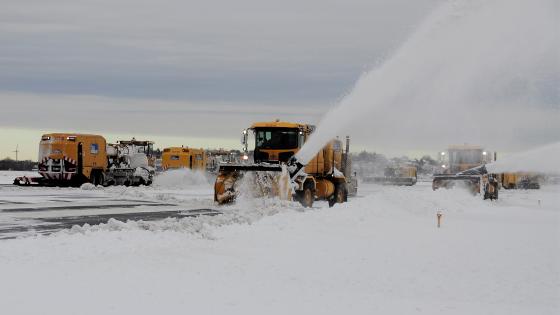
Focusing on equipment
Each year thousands of flights are delayed or cancelled in the US during the winter months, affecting the journeys of millions of passengers. In December 2022, Minneapolis-Saint Paul International Airport was forced to close its runways due to heavy snowfall and poor visibility, for example, while at the beginning of the year, New York’s LaGuardia Airport and John F Kennedy International Airports, and Boston Logan International Airport, were hit by delays and cancellations after a snow storm dumped 2ft of snow on some areas. To help airports across the country respond during this and subsequent winters, the aforementioned FAA AIP $46.2m pot will enable the purchase of snow removal equipment at Rickenbacker International in Columbus, Ohio ($3.6m), Boeing Field/King County International Airport in Seattle, Washington ($2.3m)and Ford Airport in Iron Mountain, Michigan ($607,000).
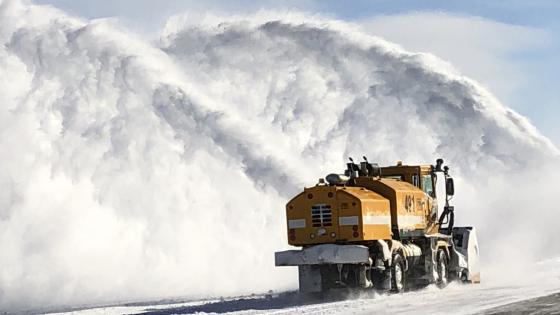
The Balchen/Post Awards recognised CVG for its handling of a large ice storm in early 2022
An additional $13.6m has been pledged to develop de-icing facilities, including a de-icing containment facility at Atlantic City International Airport in Egg Harbor Township, New Jersey, costing $9.7m, a $3.3m deicing pad at Great Falls International Airport in Great Falls, Montana and $277,777 for a de-icing pad at Williston Basin International Airport in Williston, North Dakota.
The final $16.4m will help airports construct and renovate buildings that house and maintain snow removal equipment. Among those choosing to spend their funding this way are Greenbrier Valley Airport in Lewisburg, West Virginia ($4.5m), Bellingham International Airport in Bellingham, Washington ($2.6m), Brainerd Lakes Regional Airport in Brainerd, Minnesota ($2.1m) and Mammoth Yosemite Airport in Mammoth Lake, California ($936,625).
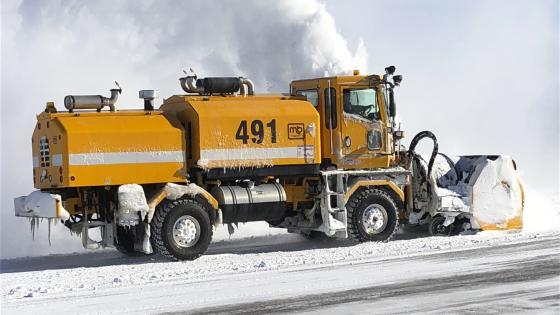
Training staff to use winter operations equipment is a key part of seasonal preparation at CVG
Tackling Boston weather
Boston Logan International Airport was another site highlighted at the Balchen/Post Awards. The hub, run by the Massachusetts Port Authority, or Massport, received an "honourable mention” (alongside Detroit Metropolitan Wayne County Airport) for its operations during the 2021-22 winter season. The airport is proud of its “carefully orchestrated plan to tackle all types of weather”, said Samantha Decker, a spokesperson for Massport. Boston Logan’s “snow crews” consist of around 100 staff who operate more than 61 specialised pieces of equipment, including a fleet of vehicles equipped with 27ft blades to clear its 10,000ft-long runwaysin just over 10 minutes.
“In Boston, we see a mix of freezing rain/icy conditions, sleet and light to heavy snowfall during the winter season,” Decker said. “We have invested in state-of-the-art equipment and hired the appropriate number of staff to make sure the airfield is treated for operations in the event of icy conditions and/or increased snowfall. Our first line of defence is the Vammas. This is a Finnish multi-purpose unit that ploughs, sweeps, and then blows any remaining snow. The machine can travel at 25mph and supports Massport’s goal to provide a high level of service to our customers, the airlines and the traveling public during winter snow emergencies at Logan Airport.”
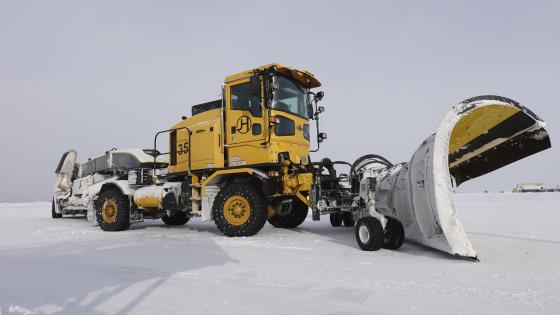
Jackson Hole Airport is the only commercial airport in the United States located inside a national park – the Grand Teton National Park
Small and beautiful
It is not just the major international airports that are making significant investments in their winter preparedness plans. Buffalo Niagara International Airport in New York State was declared winner of the Balchen/Post medium-sized commercial airport award, with Fairbanks International Airport in Alaska, Westchester County Airport in White Plains, New York, and Cincinnati/Northern Kentucky International Airport (CVG) receiving honourable mentions. The latter was recognised for its handling of a particular event in early 2022, when a large ice storm impacted the region. “At the end of the event the temperatures dropped well below freezing for several days that made it very difficult to keep surfaces open at CVG,” a spokesperson told Airports International. “Our team maintained the airfield and we never had to close it during that entire week-long event. We’re working on a plan for the 2023/2024 winter season to improve our fleet and make us even more efficient.”
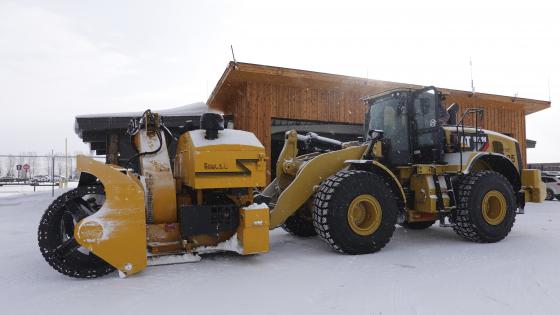
In extreme weather, Jackson Hole Airport is the only way in or out of the region
Maintaining connectivity
In a country the size of the United States, regional connectivity between smaller airports provides a lifeline to remote communities. Keeping smaller airports open year-round is therefore incredibly important. Even more so in a place like Jackson Hole, Wyoming. Here there are limited ways in and out, with just three roads and the airport. During severe storms, the airport is the only available meansof arriving or leaving the area.
Jackson Hole Airport (JAC) is in a valley in western Wyoming, nestled amid the Teton Mountain Range, a ski resort territory that knows a thing or two about adverse weather. The area has impressive yearly snowfalls averaging more than 100in on the valley floor, and over 450in in the surrounding areas, with the winter operations spanning from as early as mid-October to the start of May. The airport is also categorised as a High-Altitude Short Runway, giving JAC a unique opportunity to prove its snow removal capabilities. It won the small commercial airport category of the 2022 Balchen/Post Awards.
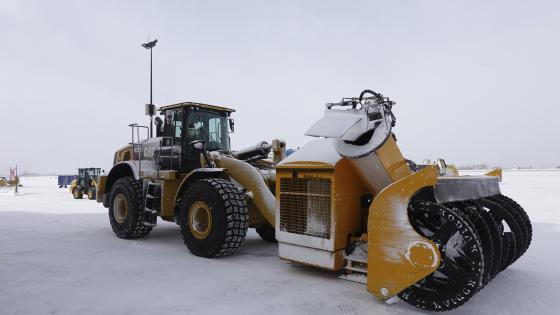
With close to 50 snow incidents over six months, Jackson Hole benefits from being able to train staff during live events
“The saying in the airport industry is if you have been to one airport, well you have been to one airport, no two airports have the exact same problems. This is no different when it comes to snow removal. Every airport is unique in its own way,” Dustin Havel, director of operations at Jackson Hole Airport, told Airports International. “We are fortunate that the snow conditions here in Jackson are typically very light and fluffy versus a heavier snow that you would expect with a lake-effect type snowfall.” But he added: “The temperatures in Jackson will rarely rise above 32°F (0°C) for a six-month period and we frequently see negative temperatures in January and February. It can be very stressful for operating equipment in these types of temperatures. Most airports will have zero tolerance for snow removal, meaning they will pre-treat surfaces and start operating equipment as soon as snow starts to stick to the surfaces. With the temperatures being as low as they are in Jackson, any forecasted precipitation will require snow removal.”
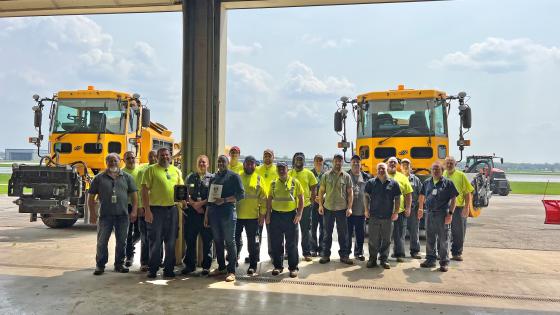
SBN has been recognised for work carried out by its operations and maintenance staff, including their planning
Recent purchases and improvements at the airport include Caterpillar 972s and assorted attachments, a Kodiak Rotary Head, RPM Rotary Head, Øveraasen runway brooms, Mercedes Benz tractors and new runway slot drains. At Jackson Hole, Havel and his team monitor the weather closely using apps, the national weather service, and runway monitoring equipment. This enables them to make projections of the depth, frequency, temperature, duration, and to estimate staffing needs for the upcoming weather event. A plan is then developed and implemented. Havel said his team has work to do even after a storm has passed – rather, this is a time when feedback is sought from all stakeholders in order to improve future training and responses to adverse conditions.
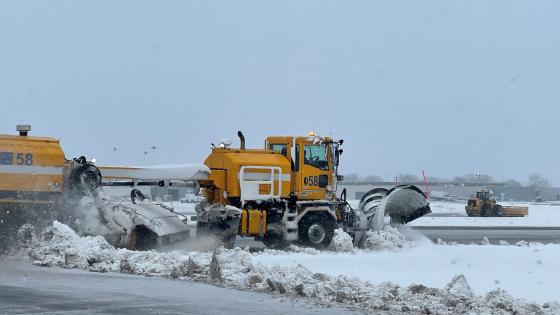
SBN’s maintenance leadership team has developed a comprehensive capital asset life-cycle replacement plan
Among the smaller airports recognised in the Balchen/Post awards for excellence in airport ice and snow control, Bangor International Airport in Maine, Frederick Douglass/Greater Rochester International Airport in New York and South Bend International Airport in Indiana all achieved honourable mentions. The latter, SBN, was recognised for work carried out by its operations and maintenance staff, including proactive planning before the winter season and before every storm. SBN recently completed a 6.3-acre commercial de-icing apron capable of serving multiple aircraft simultaneously. This project also included a new 110,000 gallon underground glycol storage system. By way of equipment, over the past two years, the airport has invested in two new MB-5 multitasking snow removal machines and a new MB-3 broom. Its maintenance leadership team has developed a comprehensive capital asset life-cycle replacement plan helping the airport stay ahead of the curve and ahead of the storms. “Operational safety is paramount in everything we do at SBN,” said Julie Curtis, vice president of marketing and development at South Bend, no doubt echoing a sentiment shared by every airport affected by winter weather, regardless of its size.
If you have been to one airport, well you have been to one airport; no two airports have the exact same problems
Need to know more: People and processes
The key to any airport’s winter ops plan is its people. Preparing for this often means hiring extra staff to carry out snow and ice clearance, operate or maintain equipment and manage passengers who will feel the knock-on effects from any delayed or cancelled flights.
At Cincinnati/Northern Kentucky International Airport (CVG), the priority is personnel. “There are two things that we do to keep CVG safe and operational during the winter months. Number one is training and preparation. We start in August and continue through the entire season. From making sure that we have contracts in place, maintaining all the equipment, to training our employees on our equipment, we are always trainingfor various scenarios,” a spokesperson explained. “Number two is consistent monitoring. We also make sure staff are taken care of, so they are healthy and prepared before a winter storm is upon us.”
A similar approach is taken at Jackson Hole Airport, where the team dedicates an entire week to snowplough training and onboarding. Most of the airport’s snow removal personnel return season after season, meaning it can focus on getting newly-hired staff members up to speed. Jackson Hole Airport also benefits from being able to train using live events.
“Given that it snows roughly 46 times over six months, it gives us ample opportunities to streamline our processes,” director of operations Dustin Havel explained. “The airport has hired some phenomenal help. Employees – including maintenance, seasonal snow removal staff, hosts, and operations personnel – are willing to work longer hours, more days, and do what is needed to get the job done.”
The introduction of more sophisticated technology means there are some tasks that no longer require on-the-ground human involvement, however. In November 2022, Memphis International Airport, home to FedEx’s largest air cargo sorting facility, unveiled its completed 3.3 million sqft de-icing pads, which are large enough to de-ice 12 wide-body cargo aircraft simultaneously. These innovative de-icing pads have message boards that eliminate the need for audio communication with pilots, taxiway lead-in lights that eliminate the need for follow-me vehicles or marshallers, and infrared cameras that help position aircraft on the bays.
